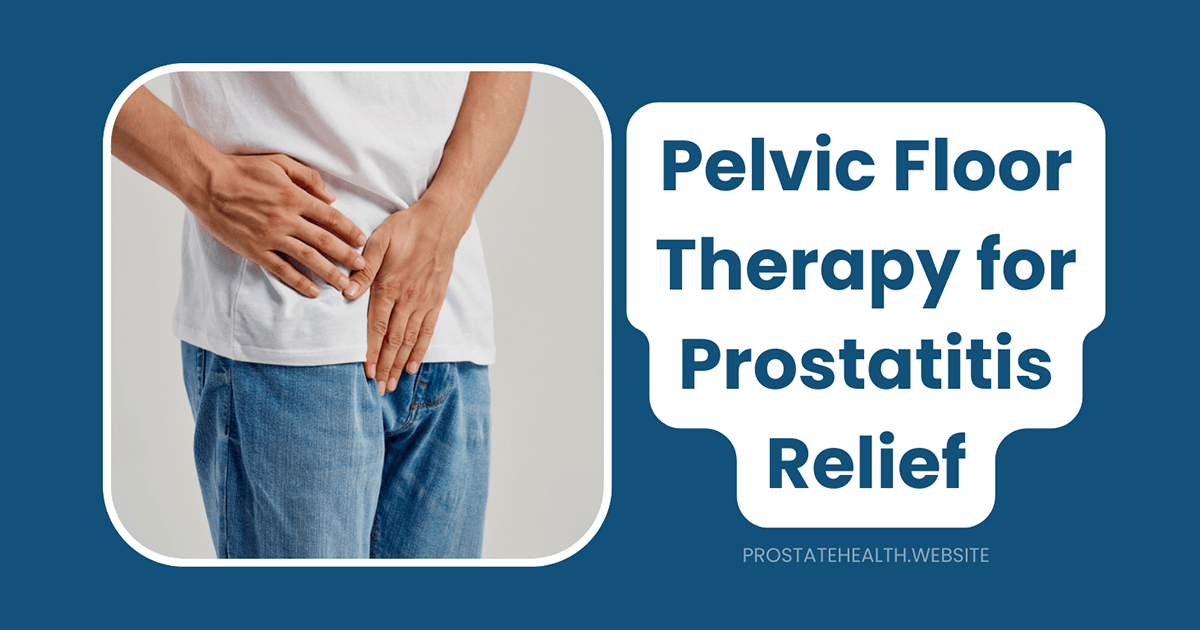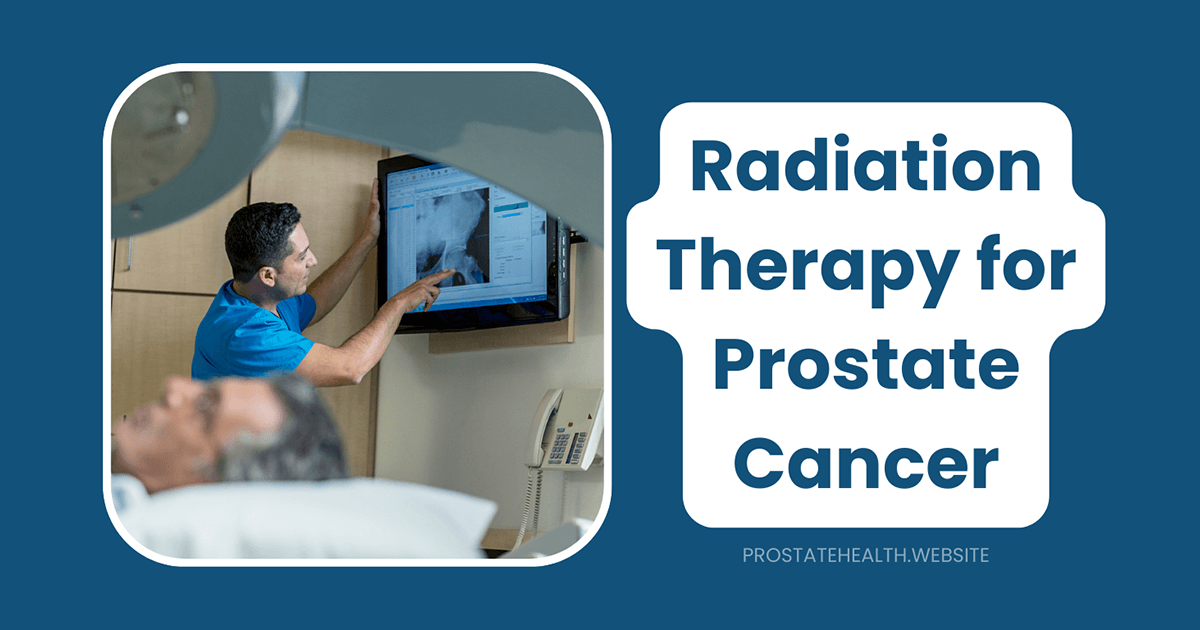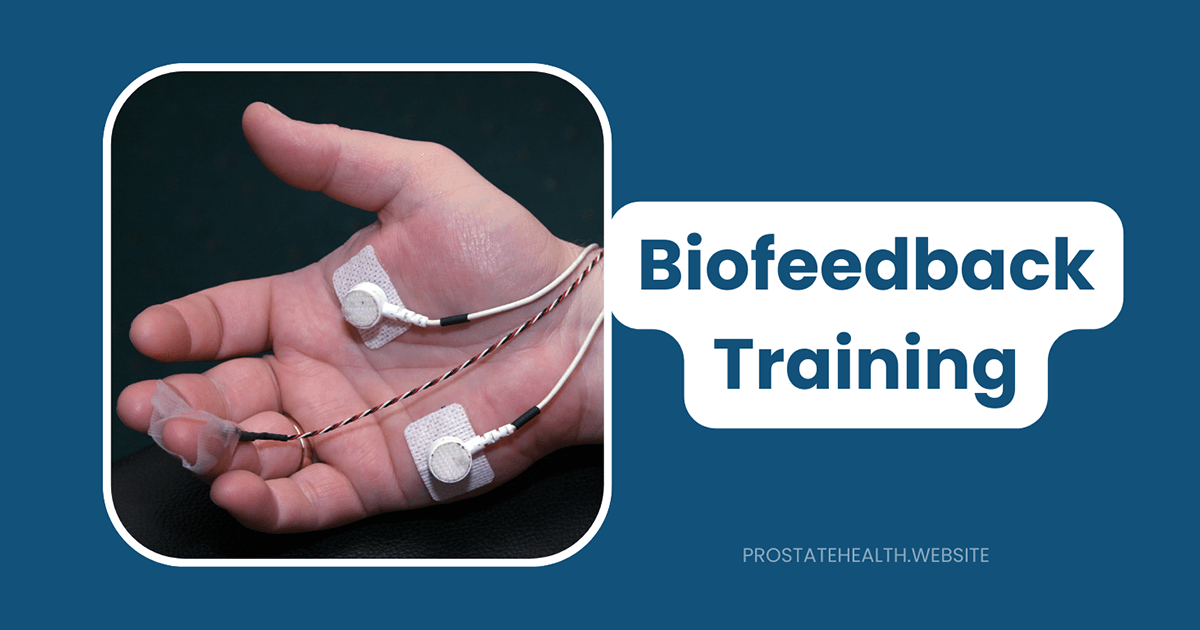Pelvic Floor Physical Therapy for Prostatitis Relief

Chronic prostatitis/chronic pelvic pain syndrome (CP/CPPS) affects approximately 2-6% of men worldwide, making it one of the most common urological conditions in men under 50. Despite its prevalence, traditional treatments like antibiotics often fail to provide relief, leaving many men frustrated and searching for effective solutions.
“What many men diagnosed with prostatitis don’t realize is that their symptoms may actually stem from dysfunction in the pelvic floor muscles rather than the prostate itself,” explains Dr. Sarah Johnson, a pelvic floor physical therapist. “This explains why antibiotics are ineffective for many patients—they’re treating the wrong problem.”
Pelvic floor physical therapy has emerged as a first-line treatment for CP/CPPS, with research showing significant improvements in pain, urinary symptoms, and quality of life. This comprehensive guide explores how pelvic floor therapy works, what to expect during treatment, and the techniques that can help provide relief from chronic prostatitis symptoms.
Understanding the Pelvic Floor-Prostatitis Connection
Before diving into treatment approaches, it’s important to understand the relationship between the pelvic floor and prostatitis symptoms.
The Male Pelvic Floor
The pelvic floor consists of a group of muscles that form a hammock-like structure at the base of the pelvis. These muscles support the pelvic organs, assist in urinary and bowel control, and play a role in sexual function. Key muscles include:
- Levator ani complex: The largest group of pelvic floor muscles
- Coccygeus: Connects the spine to the pelvis
- Obturator internus: Helps with hip movement and pelvic stability
- Piriformis: Located deep in the buttock
- External urethral sphincter: Controls urine flow
How Pelvic Floor Dysfunction Relates to Prostatitis Symptoms
Research has shown that men diagnosed with CP/CPPS often have:
- Hypertonic (tight) pelvic floor muscles: These overactive, tense muscles can cause pain and dysfunction
- Myofascial trigger points: Hypersensitive spots in the muscles that refer pain to other areas
- Poor muscle coordination: Difficulty properly relaxing and contracting these muscles
- Protective guarding: Unconscious tensing of muscles in response to pain
“Studies show that up to 85% of men diagnosed with non-bacterial prostatitis actually have pelvic floor muscle dysfunction as the primary cause of their symptoms,” notes Dr. Johnson. “This is why addressing these muscle issues can provide relief when other treatments have failed.”
Common Symptoms of Pelvic Floor Dysfunction in Men
Pelvic floor dysfunction can cause symptoms that mimic prostatitis, including:
- Pelvic pain or pressure
- Pain in the perineum (area between scrotum and rectum)
- Testicular, penile, or rectal pain
- Urinary urgency and frequency
- Pain or burning with urination
- Sexual dysfunction, including painful ejaculation
- Pain that worsens with sitting
- Lower back pain
The Evidence for Pelvic Floor Physical Therapy
Multiple studies support the effectiveness of pelvic floor physical therapy for CP/CPPS:
- A study published in the Journal of Urology found that 72% of men with CP/CPPS who underwent myofascial trigger point release and paradoxical relaxation therapy reported moderate to marked improvement in symptoms.
- Research in Physical Therapy Journal described two case studies where patients’ National Institutes of Health Chronic Prostatitis Symptom Index (NIH-CPSI) scores improved dramatically after pelvic floor therapy—one patient’s score improved from 25 to 0, while another improved from 29 to 21.
- A 2025 review in Nature found that pelvic floor physical therapy is now considered a first-line treatment for pelvic floor disorders, including those associated with prostatitis symptoms.
“The evidence is compelling,” says Dr. Robert Chen, urologist. “I now refer many of my chronic prostatitis patients for pelvic floor physical therapy, especially those who haven’t responded to traditional treatments.”
What to Expect: The Pelvic Floor Physical Therapy Process
If you’re considering pelvic floor physical therapy, here’s what the process typically involves:
1. Initial Evaluation
Your first appointment will include:
Comprehensive history:
- Detailed symptom history
- Previous treatments and their effectiveness
- Impact on daily activities and quality of life
- Medical, surgical, and medication history
- Behavioral and lifestyle factors
Physical examination:
- Posture and movement assessment
- Evaluation of hip, low back, and abdominal muscles
- External pelvic floor muscle assessment
- Internal pelvic floor examination (if appropriate)
- Assessment for trigger points and muscle tension
“The initial evaluation is thorough because we need to understand all the factors contributing to your symptoms,” explains Dr. Johnson. “This helps us develop a personalized treatment plan that addresses your specific needs.”
2. Treatment Plan Development
Based on the evaluation findings, your physical therapist will develop a customized treatment plan that may include:
- Frequency and duration of therapy sessions
- Specific techniques to address your symptoms
- Home exercise program
- Lifestyle modifications
- Goals and expected outcomes
Most patients attend weekly sessions initially, with frequency decreasing as symptoms improve. The total duration of therapy varies but typically ranges from 8-12 weeks, though some patients may need longer treatment.
3. Regular Treatment Sessions
Each session typically lasts 45-60 minutes and may include various techniques (discussed in detail below), such as:
- Manual therapy techniques
- Biofeedback training
- Therapeutic exercises
- Education on self-management strategies
4. Progress Assessment
Your therapist will regularly assess your progress using:
- Symptom questionnaires (like the NIH-CPSI)
- Physical examination findings
- Your reports of symptom changes
- Functional improvements
5. Discharge and Maintenance
Once you’ve achieved your goals, your therapist will:
- Provide a home maintenance program
- Offer strategies to prevent symptom recurrence
- Schedule any needed follow-up appointments
Key Techniques Used in Pelvic Floor Physical Therapy
Pelvic floor physical therapy employs various techniques to address muscle dysfunction:
1. Manual Therapy Techniques
External Myofascial Release:
- Gentle, sustained pressure applied to tight fascia and muscles
- Targets areas like the lower abdomen, inner thighs, buttocks, and low back
- Helps release restrictions in connective tissue
- Improves blood flow and reduces pain
Internal Trigger Point Release:
- Performed via the rectum to directly access pelvic floor muscles
- Involves applying pressure to specific trigger points
- Releases hypertonic muscles and reduces referred pain
- Typically performed with a gloved finger using gentle, precise pressure
Connective Tissue Manipulation:
- Addresses restrictions in the fascia surrounding muscles
- Uses skin rolling and gentle stretching techniques
- Improves tissue mobility and reduces pain
Visceral Mobilization:
- Gentle techniques to improve mobility of pelvic organs
- Reduces tension on surrounding structures
- Improves overall pelvic function
“Manual therapy is often the cornerstone of treatment,” notes Dr. Johnson. “These hands-on techniques can provide immediate relief and prepare the muscles for retraining.”
2. Biofeedback Training
Biofeedback uses sensors to provide real-time information about muscle activity, helping patients learn to control their pelvic floor muscles:
- Surface EMG: Electrodes placed on the skin detect muscle activity
- Internal sensors: Provide feedback on internal muscle tension
- Visual feedback: Computer displays show when muscles are contracting or relaxing
- Audio feedback: Sounds indicate muscle states
This technology helps patients:
- Identify when muscles are unnecessarily tense
- Learn to consciously relax the pelvic floor
- Improve coordination of muscle contraction and relaxation
- Gain awareness of subtle muscle patterns
3. Therapeutic Exercises
Specific exercises help retrain the pelvic floor muscles:
Pelvic Floor Relaxation:
- Diaphragmatic breathing coordinated with pelvic floor release
- “Pelvic floor drops” to practice conscious relaxation
- Visualization techniques to enhance relaxation
Stretching Exercises:
- Hip stretches (piriformis, hip flexors, adductors)
- Lower back stretches
- Abdominal stretches
Functional Training:
- Proper sitting posture
- Correct body mechanics for daily activities
- Movement patterns that minimize pelvic floor tension
General Exercise Recommendations:
- Appropriate aerobic activities
- Core strengthening with proper technique
- Activities that promote overall relaxation
4. Advanced Techniques
Several advanced techniques may be incorporated into treatment:
Electrical Stimulation:
- Low-level electrical current to reduce muscle spasm
- Can help desensitize hypersensitive areas
- May improve blood flow and promote healing
Therapeutic Ultrasound:
- Deep heating of tissues to improve blood flow
- Reduces inflammation and promotes healing
- Particularly useful for specific trigger points
Low-Intensity Extracorporeal Shockwave Therapy (LiESWT):
- Uses soundwaves to stimulate healing in soft tissues
- Reduces pain and improves tissue function
- Emerging evidence supports its use for pelvic pain
Self-Help Techniques to Complement Professional Therapy
Your physical therapist will likely teach you several techniques to practice at home:
1. Diaphragmatic Breathing
How to practice:
- Lie on your back with knees bent
- Place one hand on your chest and one on your abdomen
- Breathe in slowly through your nose, allowing your abdomen to rise (not your chest)
- Exhale slowly through pursed lips, feeling your abdomen fall
- Practice for 5-10 minutes, 2-3 times daily
Benefits: Promotes relaxation of the pelvic floor, reduces overall tension, and activates the parasympathetic nervous system.
2. Pelvic Floor Drops
How to practice:
- Sit comfortably on a chair or exercise ball
- Take a deep breath in
- As you exhale, visualize your pelvic floor relaxing and dropping downward
- Feel the muscles of your pelvic floor lengthen and release
- Hold this relaxed state for 30-60 seconds
- Repeat 5-10 times, several times daily
Benefits: Directly targets pelvic floor tension and teaches conscious relaxation of these muscles.
3. Stretches for Related Muscle Groups
Key stretches:
- Happy Baby Pose: Lie on back, hold feet with knees bent toward armpits
- Child’s Pose: Kneel with buttocks on heels, stretch arms forward, rest forehead on floor
- Piriformis Stretch: Lie on back, cross ankle over opposite knee, pull knee toward chest
- Hip Flexor Stretch: Kneel with one foot forward in lunge position, gently press hips forward
Benefits: Releases tension in muscles connected to the pelvic floor, improves overall flexibility.
4. Self-Massage Techniques
External techniques:
- Gentle massage of lower abdomen in circular motions
- Tennis ball or foam roller for buttocks and inner thighs
- Gentle pressure on tender points around the pelvis
Benefits: Helps release trigger points and tight fascia between therapy sessions.
“Consistency with home exercises is crucial for success,” emphasizes Dr. Johnson. “The patients who practice daily typically see the fastest and most significant improvements.”
Real-Life Success Stories
Many men have found relief through pelvic floor physical therapy:
David’s Story: A 33-year-old diagnosed with prostatitis who experienced no relief from six weeks of antibiotics. After eight weeks of pelvic floor therapy focusing on myofascial release and trigger point therapy, he reported being nearly pain-free and able to run over three miles with minimal discomfort.
Michael’s Story: A 45-year-old with a five-year history of chronic prostatitis who had tried multiple medications without success. After 12 sessions of pelvic floor therapy, his NIH-CPSI score improved from 25 to 0, and he was able to discontinue all pain medications.
Robert’s Story: A 52-year-old with severe pelvic pain that interfered with sitting at work. Through a combination of internal and external manual therapy techniques and a dedicated home exercise program, he experienced a 70% reduction in pain within three months.
“What’s remarkable about these success stories is that many of these men had suffered for years, trying numerous treatments without relief,” notes Dr. Chen. “Pelvic floor therapy was transformative for them.”
Finding a Qualified Pelvic Floor Physical Therapist
Not all physical therapists are trained in pelvic floor rehabilitation. Here’s how to find a qualified provider:
Specialized Training
Look for therapists with:
- Advanced training in pelvic health
- Certification in pelvic physical therapy
- Experience treating male pelvic pain
- Membership in organizations like the American Physical Therapy Association’s Pelvic Health Section
Questions to Ask Potential Providers
- What is your experience treating men with chronic prostatitis/pelvic pain?
- What specific techniques do you use for this condition?
- What is your approach to internal manual therapy?
- How many sessions might I need?
- What is your success rate with this condition?
Where to Search
- Ask your urologist for referrals
- Contact physical therapy clinics and ask about pelvic health specialists
- Use the American Physical Therapy Association’s Find a PT directory
- Search the Herman & Wallace Pelvic Rehabilitation Institute’s practitioner directory
“Finding the right therapist is crucial,” advises Dr. Johnson. “Don’t hesitate to interview potential providers to ensure they have the specific expertise needed for your condition.”
Overcoming Hesitation: Addressing Common Concerns
Many men feel hesitant about pelvic floor physical therapy, particularly regarding internal techniques. Here’s how to address common concerns:
Concern: Discomfort or Pain During Treatment
Reality: While some techniques may cause temporary discomfort, therapists work within your tolerance level. Treatment should never cause severe pain, and communication with your therapist ensures comfort.
Concern: Embarrassment About Internal Examination
Reality: Pelvic floor physical therapists are healthcare professionals who perform these examinations routinely. They maintain professionalism and respect your dignity throughout the process.
Approach: Internal techniques are only performed with your explicit consent, and therapists explain each step before proceeding. You can stop the examination at any time.
Concern: Questioning Effectiveness
Reality: Research consistently demonstrates the effectiveness of pelvic floor physical therapy for CP/CPPS, with success rates of 70-80% in multiple studies.
“I was extremely hesitant about the internal examination,” shares James, 48. “But my therapist was professional and explained everything beforehand. The relief I’ve experienced has been well worth overcoming my initial discomfort.”
Integrating Pelvic Floor Therapy with Other Treatments
Pelvic floor physical therapy often works best as part of a comprehensive treatment approach:
Complementary Treatments
Medical Management:
- Appropriate medications for pain or inflammation
- Treatment of any concurrent conditions
Psychological Support:
- Stress management techniques
- Cognitive behavioral therapy for chronic pain
- Mindfulness practices
Lifestyle Modifications:
- Dietary changes to reduce bladder irritation
- Appropriate exercise recommendations
- Ergonomic adjustments for sitting
“A multidisciplinary approach often yields the best results,” explains Dr. Chen. “Pelvic floor therapy addresses the muscular component, while other treatments target different aspects of the condition.”
The Future of Pelvic Floor Therapy for Prostatitis
The field of pelvic floor physical therapy continues to evolve, with several exciting developments on the horizon:
Technological Advancements
- Enhanced Biofeedback Systems: More sophisticated, user-friendly devices for home use
- Telehealth Applications: Remote monitoring and guidance for home exercise programs
- Wearable Technology: Devices that provide real-time feedback on pelvic floor activity throughout the day
Treatment Innovations
- Integrated Protocols: Standardized, evidence-based approaches combining multiple techniques
- Preventive Applications: Using pelvic floor therapy to prevent recurrence in high-risk individuals
- Combination Therapies: Novel approaches combining physical therapy with other modalities
Research Directions
- Larger, more rigorous clinical trials
- Investigation of optimal treatment duration and frequency
- Identification of patient characteristics that predict treatment success
“The field is advancing rapidly,” notes Dr. Johnson. “As research continues to demonstrate the effectiveness of pelvic floor therapy, we’re seeing more innovation and acceptance of these approaches.”
Conclusion: A Path to Relief
Chronic prostatitis/chronic pelvic pain syndrome can be a frustrating, debilitating condition that significantly impacts quality of life. For many men, traditional treatments fail to provide relief because they don’t address the underlying pelvic floor dysfunction that often drives symptoms.
Pelvic floor physical therapy offers a scientifically-supported approach that directly targets muscle tension, trigger points, and coordination issues that contribute to pain and urinary symptoms. Through a combination of manual techniques, biofeedback, therapeutic exercises, and education, this specialized therapy can provide significant relief when other treatments have failed.
If you’re struggling with chronic prostatitis symptoms, consider discussing pelvic floor physical therapy with your healthcare provider. With the right therapist and a commitment to your home program, you may find the relief you’ve been seeking.
“The most rewarding part of my work is seeing men who have suffered for years finally find relief,” says Dr. Johnson. “Pelvic floor therapy doesn’t just reduce symptoms—it helps restore confidence, function, and quality of life.”






